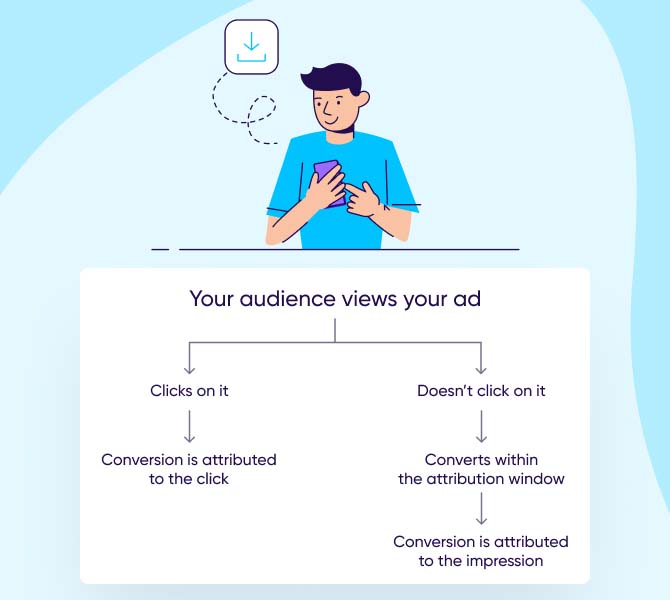
View-through attribution (VTA)

View-through attribution (VTA) refers to attributing conversions (app installs, re-attribution, re-engagement) to ad impressions. Also known as impression tracking, VTA helps measure and optimize the performance of your ad campaigns.
What is view-through attribution?
A model used to measure ad performance and spending, VTA attributes conversions to ad impressions even when a user doesn’t click on the ad.
In other words, VTA helps advertisers track conversions that happen when a user views an ad but doesn’t click on it right away. Instead, the user could download your app directly from the app store. They might have already been familiar with your app or brand, and the ad gently nudged them to install the app.
You can use VTA to measure the performance of different types of ads, including video and banner ads. It helps you determine whether your impression-based ads are resulting in authentic conversions.
How does VTA work?
View-through attribution (VTA) works by assigning a predefined view-through lookback window for each campaign. The lookback window, also known as the attribution window, is the period after an impression when a conversion may be attributed to it.
It’s worth noting that conversion, in this case, can refer to any desired action that you want users to take. Typically, it refers to:
- App install
- Re-attribution
- Re-engagement
- Purchase
VTA’s attribution window can range between 1 hour and 24 hours, with the standard being 24 hours, which means any conversion within 24 hours after a user views an ad is attributed to that particular impression.
It’s essential to point out that the attribution window varies depending on the market and industry. For instance, mature markets like the US and Singapore have longer attribution windows. In other words, users in these countries take more time to convert.
Additionally, the attribution window is longer for industries like finance, education, and e-commerce. On the other hand, attribution windows for gaming, health, and fitness apps are closer to 24 hours.
The reason?
Downloading a game, for instance, doesn’t require as much thought as a financial app would. This leads to shorter attribution windows. It’s also understandable, considering that advertisers in these industries have established ad networks designed to convert users.
Therefore, advertisers must choose the most suitable attribution window based on their industry and target market segment.
Besides determining the attribution window, you also have to share ad impression data with relevant ad networks, which will ensure accurate and timely attribution of conversions to the correct impressions.
View-through attribution vs. click-through attribution

Advantages of CTA over VTA
Unlike VTA, click-through attribution (CTA) measures conversions when a user clicks on an ad and takes the desired action. In other words, it’s the technique of tracking clicks on an ad campaign and attributing conversions to those clicks.
With CTA, advertisers can precisely identify clicks (and, in turn, impressions) that result in an app install. It eliminates the need to wait throughout the lookback period before attributing a conversion.
CTA helps establish a more direct link between an ad and the user’s actions. That, in turn, makes it easier for advertisers to measure the impact of their ad campaigns.
Drawbacks of CTA over VTA
However, the main drawback of CTA is that it doesn’t give advertisers an accurate assessment of different advertising channels.
Let’s say a user installs an app from Google Play, but the reason they downloaded the app is that they saw a YouTube ad earlier in the day. They might also have seen a banner ad for the app on a popular blog.
Instead of clicking on any of these ads, the user decided to head to Google Play at a more convenient time to install the app, maybe to avoid disrupting their viewing experience on YouTube.
In such a scenario, relying on CTA will lead you to believe that YouTube ads and banner ads aren’t working for your target audience. That, in turn, will prompt you to over-invest in other advertising channels, such as Facebook Ads or Google Ads. That is, however, misleading and far from the truth.
VTA helps overcome that drawback by providing an accurate overview of each advertising channel. Even if a user doesn’t act right after seeing an ad, you’ll know that the impression contributed to a conversion during the lookback window.
Benefits of view-through attribution
The most significant benefit of VTA is that it helps monitor channel performance. The use of an extended lookback window helps to determine how each channel affects conversions accurately. And this, lets you identify the best-performing channels for connecting with your target audience and driving conversions.
Furthermore, VTA helps you assess the performance of individual ad campaigns better. You’ll know how many conversions a campaign yields within a given period, which, will help you optimize the ad campaign’s performance and generate more conversions.
Ultimately, it eliminates the hassle of over-investing in channels that don’t result in many conversions. Instead, you can increase ad spending in the best-performing channels to target the right users and drive a greater conversion rate, which will maximize the return on investment (ROI) of your campaigns.
VTA is beneficial for industries where customers need more prolonged exposure and consideration cycles. Specifically, VTA delivers excellent results for advertisers in the finance, OTT, and e-commerce sectors.
Drawbacks of view-through attribution
VTA adoption hasn’t been uniform across all industries despite its remarkable benefits. One of the primary reasons behind this is the ambiguity surrounding the attribution window.
Novice marketers often select an attribution window that’s too short or too long for their target audience, which makes it difficult to get a clear picture of the performance of each channel’s ad campaign.
For instance, a generous attribution window might over-emphasize the importance of specific channels that don’t yield enough conversions. Similarly, a shorter window could result in the elimination of otherwise viable channels.
Additionally, advertisers sometimes struggle to establish a direct link between ad impressions and user intent. This is because it doesn’t involve a distinct user action, such as an easily tracked click, before attributing conversions.
For instance, you’ll never know with complete certainty whether an impression led to an eventual app install. It creates room for a slight degree of assumption.
Another crucial drawback is the likelihood of ad fraud. Unlike clicks, views are easier to fake using bots. That makes VTA susceptible to ad fraud and could take a toll on your campaign ROI.
CTA and VTA: the powerhouse combination
The shortcomings of VTA become more pronounced when you’re dealing with video ads. However, you can overcome these drawbacks by using a combination of CTA and VTA to measure ad performance.
For instance, you can use CTA to measure installs that directly result from a user viewing an ad and clicking on the call-to-action.
Additionally, you can use VTA to measure installs and clicks resulting within a specific period after the initial exposure. That said, be sure to set a suitable attribution window based on your industry and target audience.
Judicious use of CTA and VTA will help you tackle the ambiguity involved in tracking impressions and attributing installs. Ultimately, you’ll better understand ad spending and channel performance. It isn’t surprising then, that advertisers achieve 113% faster ad optimization and more stable auction spending by integrating CTA and VTA.

What does SKAdNetwork mean for VTA?
Recent iOS versions have underlined strict user-level data policies to protect users’ privacy. That means IDFAs or device-level identifiers will become more challenging to get hold of on iOS 14+ devices for the purpose of app measurement.
For non-Android apps, this means getting a user’s permission to collect and share their data in order to improve their personalized ad experience. And so far, an average of 46% of users opt-in to allow such permissions.
Traditionally, advertisers use mobile measurement partners (MMPs) to track user activity on apps. However, with the newer iOS versions, solutions such as SkAdNetwork – Apple’s in-house attribution solution – can allow you to access conversion data and optimize your campaigns accordingly.
The latest version, SkAdNetwork2.2, gives a fair idea of supported ad types and attribution logic. But, be sure to test how the API measures and records view-through attribution before implementing new ads. It’s also crucial to note that the new SkAdNetwork API will favor StoreKit ads instead of view-through ads.
Key takeaways
View-through attribution (VTA) is a conversion tracking model used to measure ad performance. It helps advertisers accurately identify channels and campaigns that lead to conversions.
VTA offers the following benefits:
- Improved visibility into the best-performing ad channels
- Better insight into the user journey
- A better understanding of upper and middle-funnel performance
- Improved optimization of ad spending
- Increased ROI
However, VTA has the following drawbacks:
- The ambiguity surrounding the suitable attribution window
- Lack of a direct link between user actions and impressions
- Increased vulnerability to ad fraud
These drawbacks make it necessary to come up with an approach that combines VTA and CTA.
Using a mix of these techniques, will allow you to accurately attribute your conversions to the ads, give you better insight into your campaign performance, and pave the way for the optimization of future campaign strategies.



